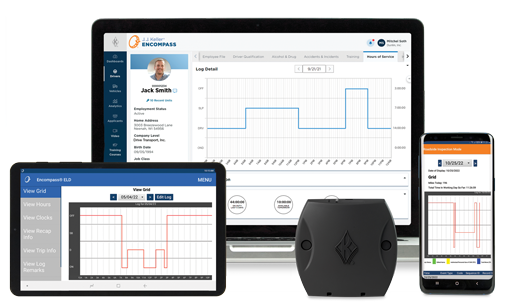Sr. Transportation Management Editor — J. J. Keller & Associates, Inc.
ELD Data: 4 Things Every Fleet Should Know
While ELDs are ideal for HOS management, the volume of data is overwhelming and can expose your operation to new risks.
Published On: 09/08/2017


Written by:
Mark Schedler
Most electronic logging device (ELD) systems collect a lot of data. The good news is that more data allows you to better track Hours of Service compliance and other issues, like detention time, equipment utilization, driver availability and performance. However, the volume of data can be crushing to manage and expose your operation to new risks.
Consider these four things you should know about ELD data:
ELDs Change On-Site Audits
When FMCSA investigates Hours of Service compliance at a carrier using an electronic logging system, the audit will be much different than the audit done at a carrier that uses paper logs. At a carrier using an electronic logging system (an AOBRD or ELD) the records or data will accurately show when the driver was driving. Consequently, the investigator will take advantage of the data the system retains in order to identify drivers who are falsifying or otherwise possibly cheating on their logs.
Some people believe that when an electronic logging system is used, “cheating” goes away. It doesn’t. It simply gets more technical.
Unassigned Driving Events Pose New Hurdles
“Unassigned driving events” occur any time a vehicle shows movement in the ELD system but there’s no driver to whom the miles should be “assigned.” This frequently occurs when drivers with ELogs forget to log in or log out of their system. The ELD captures the vehicles movement off the engine’s diagnostics but since the driver didn’t log in, it doesn’t know who to assign it to.
These events don’t exist with paper logs and many carriers are unprepared for the volume of unassigned driving events that occur with ELogs. Someone within your organization will need to be responsible for determining which driver should receive the unassigned drive time, then edit and document the ELog and correct it in the ELD system’s back office.
ELD Data Tells a Story
The data from ELDs tell a story – where the driver was, what he was doing, and how long he was doing it. If your driver is in an accident, the data from the ELD system will likely be subpoenaed. That data could help you or hurt you. If your ELD data shows that you’re a safe and compliant company, then you’re going to be alright at the end of the day. You may still end up paying some damages, but they won’t be excessive. On the flip side, if the data shows that you’re not operating safely and compliantly, you’ll be in serious trouble.
The regulations make it abundantly clear that it’s your responsibility to ensure that your drivers obey the safety regulations, including the Hours of Service regulations.
ELDs Don’t Make You Compliant
The truth is that ELDs don’t make your drivers compliant. If used correctly, ELD systems can help you see violations and trends in your Hours of Service compliance program. It can help you identify problematic driver behavior through the observation of driver’s speed, idle time, hard braking and other driver behaviors. But all this assumes someone at your carrier is reviewing and acting on the information the ELDs provide.
Basically, ELDs can help make you compliant if you use the data to proactively identify and address non-compliant driver behaviors. It’s up to you to make sure your drivers and supervisors know how to use the system and follow the hours of service regulations. Create updated ELD policies and procedures and ensure everyone knows about them and management enforces them.
Don’t be fooled into thinking ELDs make you compliant. Make a commitment to properly manage your ELD data to reduce risk and improve your fleet’s safety.
You may also enjoy the following articles:
Sign up for our newsletter!
We'll help you stay on top of regulations, best practices, and fleet industry news. Sign up to receive a monthly email notification with links to our most recent blog articles, free resources, and event invites.
